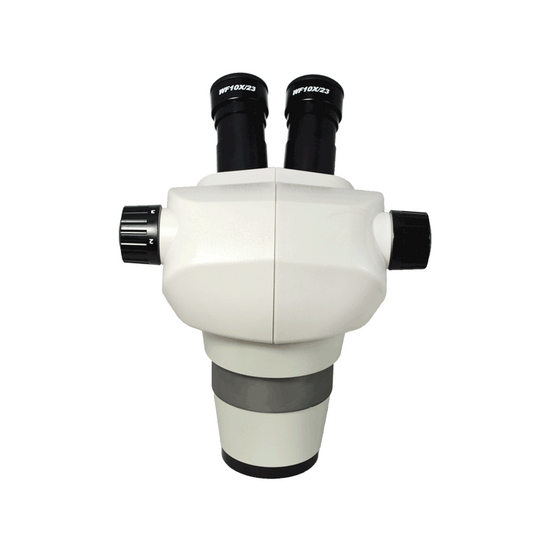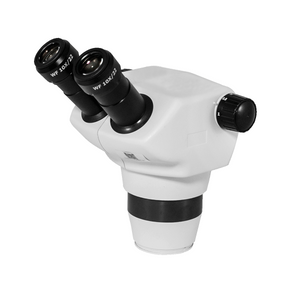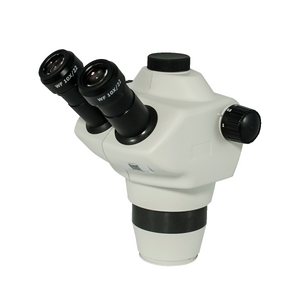Instruction Manual
SZ0403 Binocular Zoom Body Instruction Manual-English.pdf
Quick Overview
Finite. Body Magnification: 6-50X. Zoom Range: 0.6-5X. Zoom Ratio: 1:8.3. Binocular. Body Mounting Size for Stand: Dia. 76mm. Magnification Detent : 1X per pre-set stop. Eye Tube Angle: 45°. Eye Tube Inner Diameter: Dia. 30mm. Standard Eyepiece. Eyepiece Optical Magnification: 10X. Eyepiece Size for Eye Tube: Dia. 30mm. Eyepiece Field of View: Dia. 23mm. Eyepiece Diopter Correction: ±5°. Built-in Objective Magnification: 1X. Objective Working Distance: 115mm.
SZ0403 Binocular Zoom Body Instruction Manual-English.pdf
Quick Overview
Finite. Body Magnification: 6-50X. Zoom Range: 0.6-5X. Zoom Ratio: 1:8.3. Binocular. Body Mounting Size for Stand: Dia. 76mm. Magnification Detent : 1X per pre-set stop. Eye Tube Angle: 45°. Eye Tube Inner Diameter: Dia. 30mm. Standard Eyepiece. Eyepiece Optical Magnification: 10X. Eyepiece Size for Eye Tube: Dia. 30mm. Eyepiece Field of View: Dia. 23mm. Eyepiece Diopter Correction: ±5°. Built-in Objective Magnification: 1X. Objective Working Distance: 115mm.
SZ04031121 Binocular Zoom Body
Binocular Zoom Body
| Body Optical System | Finite |
| Body Magnification | 6-50X |
| Zoom Range | 0.6-5X |
| Zoom Ratio | 1:8.3 |
| Zoom Operating Mode | With Two Horizontal Knobs |
| Observation Method | Binocular |
| Body Mounting Size for Stand | Dia. 76mm |
| Magnification Detent | 1X per pre-set stop |
| Nosepiece Adapter Size for Ring Light | Dia. 60mm |
| Eye Tube Adjustment Mode | Compensating |
| Eye Tube Angle | 45° |
| Erect/Inverted Image | Erect image |
| Eye Tube Rotatable | 360° Degree Rotatable |
| Interpupillary Adjustment | 55-75mm |
| Eye Tube Inner Diameter | Dia. 30mm |
| Eye Tube Fixing Mode | Elastic Tube locking |
| Eyepiece Type | Standard Eyepiece |
| Eyepiece Optical Magnification | 10X |
| Plan Eyepiece | Plan Eyepiece |
| Eyepiece Size for Eye Tube | Dia. 30mm |
| Eyepiece Field of View | Dia. 23mm |
| Eyepoint Type | High Eyepoint Eyepiece |
| Eyepiece Size for Reticle | Dia. 27mm |
| Eyepiece Diopter Correction | ±5° |
| Built-in Objective Magnification | 1X |
| Objective Working Distance | 115mm |
| Objective Screw Thread | M55x0.75mm |
| Surface Treatment | Spray Paint |
| Material | Metal |
| Color | White |
| Net Weight | 1.54kg (3.40lbs) |
Technical Info
Instructions
Binocular Zoom BodyClose Λ
| Binocular zoom body is the main body of a stereo microscope that has continuous zooming functions and observes with two eyepieces. This body usually needs to be placed on a microscope stand for use. Generally, a variety of eyepieces and objective lenses with different magnifications can be selected. A high-end stereo microscope usually has a wide range of accessories for selection. |
FiniteClose Λ
| Microscopes and components have two types of optical path design structures. One type is finite optical structural design, in which light passing through the objective lens is directed at the intermediate image plane (located in the front focal plane of the eyepiece) and converges at that point. The finite structure is an integrated design, with a compact structure, and it is a kind of economical microscope. Another type is infinite optical structural design, in which the light between the tube lens after passing the objective lens becomes "parallel light". Within this distance, various kinds of optical components necessary such as beam splitters or optical filters call be added, and at the same time, this kind of design has better imaging results. As the design is modular, it is also called modular microscope. The modular structure facilitates the addition of different imaging and lighting accessories in the middle of the system as required. The main components of infinite and finite, especially objective lens, are usually not interchangeable for use, and even if they can be imaged, the image quality will also have some defects. The separative two-objective lens structure of the dual-light path of stereo microscope (SZ/FS microscope) is also known as Greenough. Parallel optical microscope uses a parallel structure (PZ microscope), which is different from the separative two-object lens structure, and because its objective lens is one and the same, it is therefore also known as the CMO common main objective. |
Zoom RangeClose Λ
| Zoom in zoom microscope means to obtain different magnifications by changing the focal length of the objective lens within a certain range through adjustment of some lens or lens set while not changing the position of the object plane (that is, the plane of the point of the observed object perpendicular to the optical axis) and the image plane (that is, the plane of the image imaging focus and perpendicular to the optical axis) of the microscope. Zoom range refers to the range in which the magnification is from low to high. In the zoom range of the microscope, there is no need to adjust the microscope knob for focusing, and ensure that the image is always clear during the entire zoom process. The larger the zoom range, the stronger the adaptability of the range for microscope observation, but the image effects at both ends of the low and high magnification should be taken into consideration, the larger the zoom range, the more difficult to design and manufacture, and the higher the cost will be. |
Zoom RatioClose Λ
| Zoom ratio is the ratio of the maximum magnification / the minimum magnification. Expressed as 1: (ratio of maximum magnification / minimum magnification). If the maximum magnification is 4.5X, the minimum magnification is 0.7X, then the zoom ratio = 4.5 / 0.7 = 6.4, the zoom ratio will be 1:6.4. Zoom ratio is obtained by the intermediate magnification group of the microscope. When the magnification is increased or decreased by using other objective lenses, the zoom ratio does not change accordingly. |
With Two Horizontal KnobsClose Λ
| When microscope body changes the magnification, it is realized by adjusting the horizontally placed zoom knob. Because the knob is relatively small, it is therefore easier to zoom and the image is stable. For most of the dual stereo microscopes, magnification is realized by adjusting the zoom drum or nosepiece below. When the nosepiece is relatively big, frequent operation is more laborious. Magnifying while observing, the microscope may shake, thereby causing eye discomfort for observation. Using zoom drum or nosepiece type microscope, if there is a ring light under the microscope, the ring light carries the wire, and when magnification conversion is often required, the ring light and the wire will swing along with the magnification, which makes the operation inconvenient. This situation will not occur to zoom with two horizontal knobs. |
Magnification Detent Close Λ
| In the body of zoom microscope, zooming is continuous. When rotating to a certain position, generally an integral multiple, a positioning structure or detent is added, which has a distinct hand feel during the zooming process, and stops at this position. When measuring, or testing by factory for unified standard magnification, a magnification detent device can avoid the error caused by the inaccurate multiple positioning of the optical magnification. |
CompensatingClose Λ
| For compensating eyetube, when changing the interpupillary distance, it requires two hands to operate at the same time, with one hand fixing one eyepiece tube, and the other pushing or pulling the other, or both the left and the right hand pushing the two eyetubes at the same time, and changing the position of any one of the eyetube at will. |
Eye Tube AngleClose Λ
| Usually the Microscope Eyetube is 45°, some is 30°, Tiltable Eyetube Angle design of a microscope is also known as the ergonomics microscope. 0-30° or 0-45° is an ergonomic design. When the mechanical tube length / focal length of the tube of the microscope is relatively big, the microscope is relatively high, and the user's height or the seat of the work desk is not suitable, long-term use of microscope may cause sitting discomfort. Eyepiece tube with variable angle can freely adjust the angle without lowering the head. Especially when it is close to 0 degree and the human eye is close to horizontal viewing, long-time or long-term use can avoid fatigue damage to the cervical vertebra. |
Erect/Inverted ImageClose Λ
| After imaging through a set of objective lenses, the object observed and the image seen by the human eye is inverted. When the observed object is manipulated, move the specimen or object, the image will move in the opposite direction in the field of view. Most of the biological microscopes are reversed-phase designs. When needing to operate works with accurate direction, it is necessary to design it into a forward microscope. Generally stereo microscopes and metallurgical microscopes are all of erect image design. When observing through the camera and display, the erect and inverted image can be changed by the orientation of the camera. |
360° Degree RotatableClose Λ
| The eyepiece of the microscope can have different viewing or observing directions. When the position of the microscope is uncomfortable, the direction of the eyepiece tube of the microscope can be adjusted, to facilitate observation and operation. Placement method of different viewing angles of the microscope: General direction: the support column is behind the object to be observed Reverse direction: the support column is in front of the object to be observed Lateral direction: the support column is on the side of the object to be observed Rotating eyepiece tube, different microscopes may have different methods, for some, the direction is confirmed when installing the eyepiece tube of the microscope, for some, by rotating the body of the microscope, and for some, by rotating the support member on the support or holder of the microscope. |
Interpupillary AdjustmentClose Λ
| The distance between the two pupils of the human eye is different. When the image of exit pupil of the two eyepieces of the microscope are not aligned with the entry pupil of the eye, the two eyes will see different images, which can cause discomfort. Adjust the distance between the two eyepieces, to accommodate or adapt to the pupil distance of the observer's eyes. The adjustment range is generally between 55-75mm. |
Eyepiece Optical MagnificationClose Λ
| Eyepiece optical magnification is the visual magnification of the virtual image after initial imaging through the eyepiece. When the human eye observes through the eyepiece, the ratio of the tangent of the angle of view of the image and the tangent of the angle of view of the human eye when viewing or observing the object directly at the reference viewing distance is usually calculated according to 250 mm/focal length of eyepiece. The standard configuration of a general microscope is a 10X eyepiece. Usually, the magnification of the eyepiece of compound microscope is 5X, 8X, 10X, 12.5X, 16X, 20X. As stereo microscope has a low total magnification, its eyepiece magnification generally does not use 5X, but can achieve 25X, 30X and other much bigger magnification. |
Eyepiece Field of ViewClose Λ
| The eyepiece field of view is the diameter of the field diaphragm of the eyepiece, or the diameter of the image plane of the field diaphragm imaged by the field diaphragm. The diameter of a large field of view can increase the viewing range, and see more detail in the field of view. However, if the field of view is too large, the spherical aberration and distortion around the eyepiece will increase, and the stray light around the field of view will affect the imaging effect. |
Eyepoint TypeClose Λ
| Eye point refers to the axial distance between the upper end of the metal frame of the eyepiece and the exit of pupil. The exit of pupil distance of high eyepoint eyepiece is farther than that of the eye lens of the ordinary eyepiece. When this distance is greater than or equal to 18mm, it is a high eyepoint eyepiece. When observing, one does not need to be too close to the eyepiece lens, making it comfort to observe, and it can also be viewed with glasses. Generally, there is a glasses logo on the eyepiece, indicating that it is a high eyepoint eyepiece. |
Built-in Objective MagnificationClose Λ
| The objective of a stereo microscope is mostly built-in objective, which is usually mounted in the microscope body, and it is one or a set of lenses closest to the object to be observed. When not marked, the built-in objective is 1X. |
Objective Working DistanceClose Λ
| The objective working distance is the vertical distance from the foremost surface end of the objective of the microscope to the object surface to be observed. Generally, the greater the magnification, the higher the resolution of the objective, and the smaller the working distance, the smaller the field of view. Conversely, the smaller the magnification, the lower the resolution of the objective, and the greater the working distance, and greater the field of view. High-magnification objectives (such as 80X and 100X objectives) have a very short working distance. Be very careful when focusing for observation. Generally, it is after the objective is in position, the axial limit protection is locked, then the objective is moved away from the direction of the observed object. The relatively greater working distance leaves a relatively large space between the objective and the object to be observed. It is suitable for under microscope operation, and it is also easier to use more illumination methods. The defect is that it may reduce the numerical aperture of the objective, thereby reducing the resolution. |
Objective Screw ThreadClose Λ
| For microscopes of different manufacturers and different models, the thread size of their objectives may also be different. In general, the objective threads are available in two standard sizes, allowing similar objectives between different manufacturers to be used interchangeably. One is the British system: RMS type objective thread: 4/5in X 1/36in, One is metric: M25 X 0.75mm thread. |
PackagingClose Λ
| After unpacking, carefully inspect the various random accessories and parts in the package to avoid omissions. In order to save space and ensure safety of components, some components will be placed outside the inner packaging box, so be careful of their inspection. For special packaging, it is generally after opening the box, all packaging boxes, protective foam, plastic bags should be kept for a period of time. If there is a problem during the return period, you can return or exchange the original. After the return period (usually 10-30 days, according to the manufacturer’s Instruction of Terms of Service), these packaging boxes may be disposed of if there is no problem. |
Optical Data
| Microscope Optical Data Sheet | ||||||||||||
| P/N | Objective | Objective Working Distance | Eyepiece | |||||||||
| SZ04031121 (10X Dia. 23mm) | SZ04023421 (15X Dia. 16mm) | SZ17013421 (15X Dia. 16mm) | SZ04023621 (20X Dia. 12.5mm) | SZ17013621 (20X Dia. 12.5mm) | ||||||||
| Magnification | Field of View(mm) | Magnification | Field of View(mm) | Magnification | Field of View(mm) | Magnification | Field of View(mm) | Magnification | Field of View(mm) | |||
| SZ17014211 | 0.5X | 220mm | 3-25X | 9.2-76.67mm | 4.5-37.5X | 6.4-53.33mm | 4.5-37.5X | 6.4-53.33mm | 6-50X | 5-41.67mm | 6-50X | 5-41.67mm |
| SZ17014311 | 0.7X | 150mm | 4.2-35X | 6.57-54.76mm | 6.3-52.5X | 4.57-38.1mm | 6.3-52.5X | 4.57-38.1mm | 8.4-70X | 3.57-29.76mm | 8.4-70X | 3.57-29.76mm |
| SZ04031121 | 1X | 115mm | 6-50X | 4.6-38.33mm | 9-75X | 3.2-26.67mm | 9-75X | 3.2-26.67mm | 12-100X | 2.5-20.83mm | 12-100X | 2.5-20.83mm |
| SZ17014611 | 2X | 45mm | 12-100X | 2.3-19.17mm | 18-150X | 1.6-13.33mm | 18-150X | 1.6-13.33mm | 24-200X | 1.25-10.42mm | 24-200X | 1.25-10.42mm |
| 1. Magnification=Objective Optical Magnification * Body Magnification * Eyepiece Optical Magnification | ||||||||||||
| 2. Field of View=Eyepiece Field of View /(Objective Optical Magnification*Body Magnification) | ||||||||||||
| 3. The Darker background items are Standard items, the white background items are optional items. | ||||||||||||
| Packing | |
| Packaging Type | Carton Packaging |
| Packaging Material | Corrugated Carton |
| Packaging Dimensions(1) | 25x24.5x24cm (9.843x9.646x9.449″) |
| Inner Packing Material | Plastic Bag |
| Ancillary Packaging Materials | Styrofoam |
| Gross Weight | 2.11kg (4.65lbs) |
| Minimum Packaging Quantity | 1pc |
| Transportation Carton | Carton Packaging |
| Transportation Carton Material | Corrugated Carton |
| Transportation Carton Dimensions(1) | 25x24.5x24cm (9.843x9.646x9.449″) |
| Total Gross Weight of Transportation(kilogram) | 2.11 |
| Total Gross Weight of Transportation(pound) | 4.65 |
 |

















